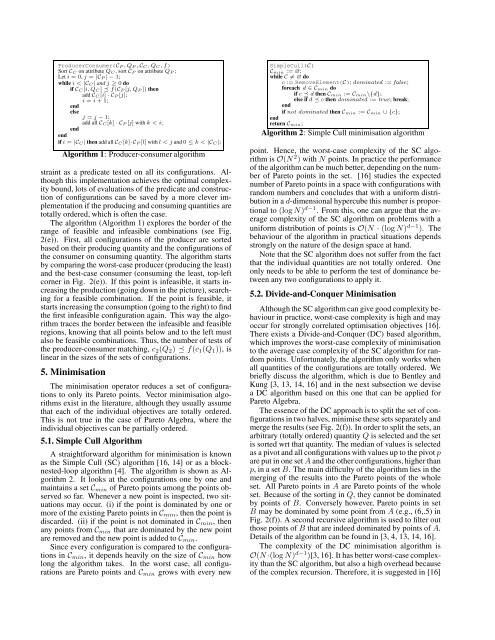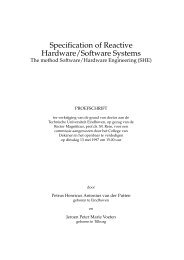A Calculator for Pareto Points
A Calculator for Pareto Points
A Calculator for Pareto Points
You also want an ePaper? Increase the reach of your titles
YUMPU automatically turns print PDFs into web optimized ePapers that Google loves.
ProducerConsumer(CP , QP , CC , QC, f)<br />
Sort CC on attribute QC, sort CP on attribute QP ;<br />
Let i = 0, j = |CP | − 1;<br />
while i < |CC| and j ≥ 0 do<br />
if CC [i, QC ] f(CP [j, QP ]) then<br />
add CC [i] · CP [j];<br />
i = i + 1;<br />
end<br />
else j = j − 1;<br />
add all CC[k] · CP [j] with k < i;<br />
end<br />
end<br />
if i = |CC| then add all CC[k]·CP [l] with l < j and 0 ≤ k < |CC|;<br />
Algorithm 1: Producer-consumer algorithm<br />
straint as a predicate tested on all its configurations. Although<br />
this implementation achieves the optimal complexity<br />
bound, lots of evaluations of the predicate and construction<br />
of configurations can be saved by a more clever implementation<br />
if the producing and consuming quantities are<br />
totally ordered, which is often the case.<br />
The algorithm (Algorithm 1) explores the border of the<br />
range of feasible and infeasible combinations (see Fig.<br />
2(e)). First, all configurations of the producer are sorted<br />
based on their producing quantity and the configurations of<br />
the consumer on consuming quantity. The algorithm starts<br />
by comparing the worst-case producer (producing the least)<br />
and the best-case consumer (consuming the least, top-left<br />
corner in Fig. 2(e)). If this point is infeasible, it starts increasing<br />
the production (going down in the picture), searching<br />
<strong>for</strong> a feasible combination. If the point is feasible, it<br />
starts increasing the consumption (going to the right) to find<br />
the first infeasible configuration again. This way the algorithm<br />
traces the border between the infeasible and feasible<br />
regions, knowing that all points below and to the left must<br />
also be feasible combinations. Thus, the number of tests of<br />
the producer-consumer matching, c2(Q2) f(c1(Q1)), is<br />
linear in the sizes of the sets of configurations.<br />
5. Minimisation<br />
The minimisation operator reduces a set of configurations<br />
to only its <strong>Pareto</strong> points. Vector minimisation algorithms<br />
exist in the literature, although they usually assume<br />
that each of the individual objectives are totally ordered.<br />
This is not true in the case of <strong>Pareto</strong> Algebra, where the<br />
individual objectives can be partially ordered.<br />
5.1. Simple Cull Algorithm<br />
A straight<strong>for</strong>ward algorithm <strong>for</strong> minimisation is known<br />
as the Simple Cull (SC) algorithm [16, 14] or as a blocknested-loop<br />
algorithm [4]. The algorithm is shown as Algorithm<br />
2. It looks at the configurations one by one and<br />
maintains a set Cmin of <strong>Pareto</strong> points among the points observed<br />
so far. Whenever a new point is inspected, two situations<br />
may occur. (i) if the point is dominated by one or<br />
more of the existing <strong>Pareto</strong> points in Cmin, then the point is<br />
discarded. (ii) if the point is not dominated in Cmin, then<br />
any points from Cmin that are dominated by the new point<br />
are removed and the new point is added to Cmin.<br />
Since every configuration is compared to the configurations<br />
in Cmin, it depends heavily on the size of Cmin how<br />
long the algorithm takes. In the worst case, all configurations<br />
are <strong>Pareto</strong> points and Cmin grows with every new<br />
SimpleCull(C)<br />
Cmin := ∅;<br />
while C = ∅ do<br />
c := RemoveElement(C); dominated := false;<br />
<strong>for</strong>each d ∈ Cmin do<br />
if c d then Cmin := Cmin\{d};<br />
else if d c then dominated := true; break;<br />
end<br />
if not dominated then Cmin := Cmin ∪ {c};<br />
end<br />
return Cmin;<br />
Algorithm 2: Simple Cull minimisation algorithm<br />
point. Hence, the worst-case complexity of the SC algorithm<br />
is O(N 2 ) with N points. In practice the per<strong>for</strong>mance<br />
of the algorithm can be much better, depending on the number<br />
of <strong>Pareto</strong> points in the set. [16] studies the expected<br />
number of <strong>Pareto</strong> points in a space with configurations with<br />
random numbers and concludes that with a uni<strong>for</strong>m distribution<br />
in a d-dimensional hypercube this number is proportional<br />
to (log N) d−1 . From this, one can argue that the average<br />
complexity of the SC algorithm on problems with a<br />
uni<strong>for</strong>m distribution of points is O(N · (log N) d−1 ). The<br />
behaviour of the algorithm in practical situations depends<br />
strongly on the nature of the design space at hand.<br />
Note that the SC algorithm does not suffer from the fact<br />
that the individual quantities are not totally ordered. One<br />
only needs to be able to per<strong>for</strong>m the test of dominance between<br />
any two configurations to apply it.<br />
5.2. Divide-and-Conquer Minimisation<br />
Although the SC algorithm can give good complexity behaviour<br />
in practice, worst-case complexity is high and may<br />
occur <strong>for</strong> strongly correlated optimisation objectives [16].<br />
There exists a Divide-and-Conquer (DC) based algorithm,<br />
which improves the worst-case complexity of minimisation<br />
to the average case complexity of the SC algorithm <strong>for</strong> random<br />
points. Un<strong>for</strong>tunately, the algorithm only works when<br />
all quantities of the configurations are totally ordered. We<br />
briefly discuss the algorithm, which is due to Bentley and<br />
Kung [3, 13, 14, 16] and in the next subsection we devise<br />
a DC algorithm based on this one that can be applied <strong>for</strong><br />
<strong>Pareto</strong> Algebra.<br />
The essence of the DC approach is to split the set of configurations<br />
in two halves, minimise these sets separately and<br />
merge the results (see Fig. 2(f)). In order to split the sets, an<br />
arbitrary (totally ordered) quantity Q is selected and the set<br />
is sorted wrt that quantity. The median of values is selected<br />
as a pivot and all configurations with values up to the pivot p<br />
are put in one set A and the other configurations, higher than<br />
p, in a set B. The main difficulty of the algorithm lies in the<br />
merging of the results into the <strong>Pareto</strong> points of the whole<br />
set. All <strong>Pareto</strong> points in A are <strong>Pareto</strong> points of the whole<br />
set. Because of the sorting in Q, they cannot be dominated<br />
by points of B. Conversely however, <strong>Pareto</strong> points in set<br />
B may be dominated by some point from A (e.g., (6,.5) in<br />
Fig. 2(f)). A second recursive algorithm is used to filter out<br />
those points of B that are indeed dominated by points of A.<br />
Details of the algorithm can be found in [3, 4, 13, 14, 16].<br />
The complexity of the DC minimisation algorithm is<br />
O(N ·(log N) d−1 )[3, 16]. It has better worst-case complexity<br />
than the SC algorithm, but also a high overhead because<br />
of the complex recursion. There<strong>for</strong>e, it is suggested in [16]
















